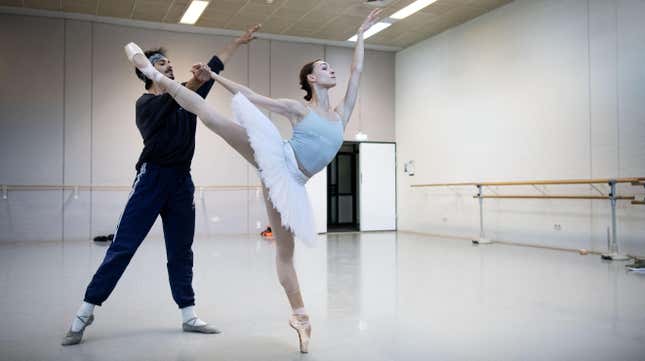Fashion Is Co-Opting the Ballet Aesthetic While Ignoring the Artform’s Ugly Self-Reckoning
As the ballet world grapples with sexual abuse allegations and its own racist past, Balletcore continues to trend innocently on TikTok and in fashion magazines.
In Depth

In Olivia Rodrigo’s “Brutal” video, which debuted in the summer of 2021, Gen Z’s preferred ingenue attempts to dance ballet in pointe shoes, only to snap her ankles and collapse on the ground. A depressed ballerina, Rodrigo crawls around the studio floor in black fishnet tights, unable to match the sameness of the dancers circling her like vultures. Tears fall down her cheeks as she contorts her face into a grimace, while fair-skinned ballerinas in pink tights carry on in their relevés, unbothered. “Who am I if not exploited?” she wonders.
Whether an intentional trendsetter or somewhat of a clairvoyant, Rodrigo’s gothic failure of a ballet performance seemed to awaken a recurring pop culture fanaticism for the ballerina as a beautiful, tortured little thing. A video of Natalie Portman’s Black Swan character having a disturbing mental breakdown onstage during a psychosexual performance of Swan Lake racked up over one million views on TikTok, and fashion has followed suit with the reintroduction of the balletcore trend: clothing items like ballet flats, wrap skirts, wrap sweaters, leg warmers, and leotards. The influence of classic ballet garb can be seen in Rodarte’s 2022 runway collection, in Miu Miu’s ad campaigns, and throughout Euphoria on Sydney Sweeney, who regularly sports a wrap top or two—a ballet style popularized by Diane von Furstenberg.
Suzanne Jolie, one of the creators behind the viral Instagram account @ModelsDoingBallet that advocates for the hiring of dancers instead of models, says that Portman’s Oscar-winning performance—namely, her six-month “transformation” into a professional ballerina—and the internet’s enduring fascination with her portrayal of a pained princess is more of a story of erasure and exploitation than it is a triumph of acting. Portman never publicly credited her dance double, American Ballet Theater dancer Sarah Lane, who claims she, not Portman, was responsible for nearly all of the intricate sequences on pointe. “She was silenced,” Jolie remembers. 2022’s balletcore resurgence hides other ugly and inconvenient truths.
Amidst well-meaning but incomplete TikToks of the history of balletcore, and elegant photo shoots featuring celebrities and fashion models in pointe shoes, the ballet aesthetic revival tells only the palatable parts of the story. Conveniently, it leaves out the systemic sexual assault, grooming, and harassment allegations that have cropped up across the ballet world over the past several years, and ignores ballet’s institutional inability to reckon with its self-perpetuated racism and fat-phobia. While Rodrigo’s “Brutal” video at least questions the dangers of the ballet ideal, journalist and author of Turning Pointe Chloe Angyal notes that the same cannot be said of 2022’s untimely pas de deux with balletcore.
“It’s sort of like an uncritical, unquestioning lifting of the visuals, iconography, and the imagery of ballet. I doubt very much that any of these designers gave any thought to the multiple controversies that have been roiling ballet in the last couple of years,” Angyal told Jezebel in an interview earlier this month. “Because ballet is a sort of shorthand for refined upper-class, effortless, athletic femininity, it’s not surprising to me that brands want to tap into that, grabbing the convenient and appealing parts of ballet and ignoring all the rest of it.”
As high-end fashion brands continue to co-opt ballet garb without taking a moment to dig into the art form’s past or ever-shifting present, they fan the flames of dancers’ fight for labor rights, power, and a voice in an industry that demands silence and subservience of its most talented artists.
Now synonymous with ballet fashion, the signature tulle gowns that comprise the DNA of modern brands like Rodarte and Simone Rocha first popped up in the 1800s. “Gauzy skirts” or tutus were the artistic evolutions of actual fashion at the time, according to the book and accompanying FIT Museum exhibition, Ballerina: Fashion’s Modern Muse, curated by Patricia Mears. In a narrated video chronicling the exhibit, Mears explains that it wasn’t until 1909 and the rise of Russian supernova Anna Pavlova that “balletomania” took over the west. In the 1930s, Mears says, the corseted tutu would go on to inspire “the most important couturiers” of the century like Coco Chanel. By 1948, ballerinas regularly starred in movies like The Red Shoes and were featured in magazines like Life as Americans clamored to get their hands on their own piece of the glamour and cream-colored beauty that ballet culture offered.
Despite ballerinas’ quick ascent to cultural royalty, Angyal points to the oppressive gatekeeping and lack of bodily agency that’s baked deeply into the art form—which demands mentioning when talking about the history of ballet fashion, no matter how ugly. Those dynamics are precisely what French impressionist artist Edgar Degas aimed to capture when he famously painted dark figures peering over the corps de ballet. “What a lot of people don’t realize when they’re looking at those Degas paintings is that all those women were impoverished. Some of them were able to create some semblance of economic stability for themselves by becoming mistresses to wealthy subscribers of the ballet, but most of them did not,” Angyal says. “Those images were understood as paintings of exhausted, hardworking, lower-class women.”
“Because ballet is a sort of shorthand for refined upper-class, effortless, athletic femininity, it’s not surprising to me that brands want to tap into that, grabbing the convenient and appealing parts of ballet and ignoring all the rest of it.”
Mears says that the 1970s would go on to mark a colossal shift in ballet’s cultural cachet, as major dance-wear companies like Danskin Inc. began to offer Americans leotards and tights marketed specifically to those who weren’t frequenting the ballet barre. At long last, everyone could partake in the United States’ fascination with petite, graceful womanhood. Fast-forward to the millennium, and brands from Free People to early aughts American Apparel released ready-to-wear ballet collections en masse, including the trend of the ballet flat. “Ballet body” fitness programs and barre-inspired workouts like Pure Barre took centerstage, and it was within this moment, says ballet dancer and self-proclaimed “mom of ballet TikTok” Minnie Lane, that the aesthetics of ballet were suddenly copy-and-pasted on capitalist-spawned products without thought.
-

-

-

-

-

-

-

-

-

-

-

-

-

-

-

-

-

-

-

-

-

-

-

-

-

-

-

-

-

-

-

-

-

-

-

-

-

-

-

-








































